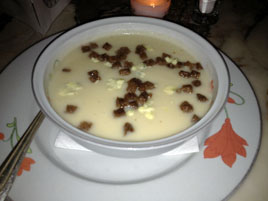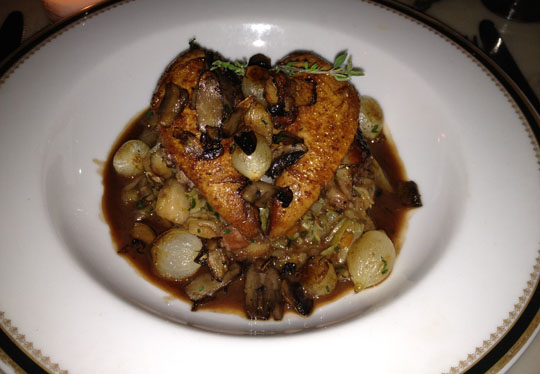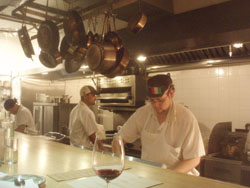Monkey Bar
 Monday, October 31, 2011 at 10:09PM
Monday, October 31, 2011 at 10:09PM 
 The business cards at Monkey Bar say in small print, “Est. 1936.” Yeah, sure it was. The space in the Hotel Elysée is that old, but nothing has lasted there except the Simian-themed décor.
The business cards at Monkey Bar say in small print, “Est. 1936.” Yeah, sure it was. The space in the Hotel Elysée is that old, but nothing has lasted there except the Simian-themed décor.
To give only the recent history: the Glaziers of steakhouse fame (Michael Jordan’s, Strip House) acquired the Monkey Bar in 1994 and hired the restaurant starchitect David Rockwell to give it a plush makeover. There was a succession of chefs, including John Schenk, Kurt Gutenbrunner, Patricia Yeo, Chris Cheung. At one time, Monkey Bar was one of the toughest doors in town.
Somewhere along the line, the Glaziers turned it into a steakhouse. By then anyone could get in, including me. I recall having a pretty good steak there in the 1990s or early 2000s: after all, good beef was one thing the Glaziers had in abundance. By 2008, it had fallen on hard times. Vanity Fair’s Graydon Carter acquired the space and closed it for restoration, installing a spectacular Edward Sorel mural in the dining room.
Carter’s idea was to create a midtown version of what he’d already achieved in Greenwich Village, at the Waverly Inn: a restaurant masquerading as a club for publishing and advertising industry moguls, celebrities, and the well connected. By July 2009, The Times reported that Carter spent 20 minutes a day, 7 days a week, laying out the seating chart of the two restaurants:
Although hardly any critics have reviewed the Monkey Bar yet — and the first chef was fired — prime reservations are already nearly impossible for anyone other than the famous or well connected…
For a while, there was a phone number people could call to reach a reservationist. No more.
“We were getting 1,000 calls a day,” said Mr. Klein in an interview at the bar at the Algonquin Hotel on West 44th Street, next to a property he owns, the City Club Hotel. “It’s hard on the phone to say, ‘I’m sorry, we don’t have a place for you.’ It’s easier by e-mail. People get upset on the phone.”
So now there is an e-mail address…although 90 percent of reservations are made through the partners — that is, by people who know them or have some connection and reach them directly.
The one thing it lacked was food worth paying for. Within five weeks of opening, Carter fired the chef, Elliot Ketley, replacing him with culinary legend Larry Forgione, who was there only as a consultant until a permanent chef could be found. Forgione was on hand when Frank Bruni awarded a weak star, finding a menu strewn with “many mishaps.” That accomplished, Forgione gave way to Josh Moulton.
It turns out that there’s a limit to the number of people who will sign up for expensive, mediocre cuisine, and Monkey Bar had surpassed it. Before long, it was on OpenTable and reservable any day, any time, at short notice. Lunch service was dropped in the dining room.
Give Carter credit for recognizing that he’d run the restaurant into a ditch, and needed a full-scale talent make-over. To fix the place, he brought in the restaurant equivalent of the 1927 Yankees: managing partner and front-office genius Ken Friedman (The Spotted Pig, The Breslin, The John Dory), chef Damon Wise (Craft, Colicchio & Sons), sommelier and GM Belinda Chang (The Modern), and cocktail whiz Julie Reiner (Flatiron Lounge, Clover Club).
The question is how long Carter can keep this team together. Wise admits that he plans to open a downtown restaurant in 2012. The Monkey Bar is in essence a stop-gap for him until that space is ready, though he insists he will remain executive chef here. Reiner is only consulting, and Friedman has places all over town, which leaves only Chang with a full-time commitment to the restaurant.
For now, though, let’s enjoy what they have accomplished, which in a few short weeks is something remarkable, given what they started with.
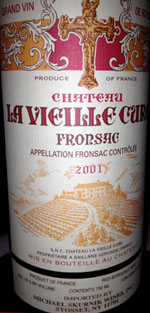 Chang’s wine list is just a few pages long. Reprinted daily, it comes in a cardboard folder with the leaves stapled together. About equally balanced between the United States and France, I assume it is a work in progress. You won’t find much below $50, whether red or white, but if you’re willing to spend a bit more, there are some older Bordeaux worth a look.
Chang’s wine list is just a few pages long. Reprinted daily, it comes in a cardboard folder with the leaves stapled together. About equally balanced between the United States and France, I assume it is a work in progress. You won’t find much below $50, whether red or white, but if you’re willing to spend a bit more, there are some older Bordeaux worth a look.
Perhaps the 2001 Château La Vieille Cure was a hold-over from prior management. At $80, it qualifies as a bargain on this list. Chang has stocked the place with proper Bordeaux glasses, but not decanters, and a wine this old really ought to be decanted. After a while, it opened up beautifully, and was well worth the price.
Wise’s menu is a complete departure from the brasserie food that Monkey Bar was serving a couple of years ago, with a fairly close stylistic resemblance to Colicchio & Sons, his last stop after many years previously at Craft. It’s priced for the midtown corporate crowd, with appetizers and pastas mostly $19–23, entrées mostly $29–36. There are a few outliers, like the ubiquitous côte de boeuf for two ($135) and pasta with truffles ($55): this is a Graydon Carter restaurant, after all.
But with an excellent bread service, an amuse bouche, and petits fours at the end, you are getting your money’s worth. In the early days, the menu is promising. If the execution isn’t quite perfect, it’s certainly miles ahead of Colicchio & Sons, in a far nicer room.
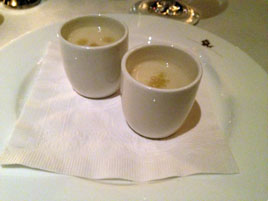
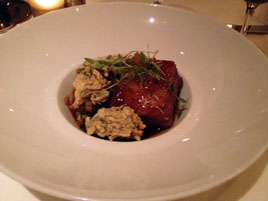
The amuse bouche (above left) was a small cup of celery root soup with diced apples. To start, we shared the Braised Pork Belly ($21; above right) with crispy deep-fried oysters and kimchee, a well conceived but slightly cloying dish.


Both entrées were impressive productions, though verging on the edge of over-worked. Halibut ($31; above left) was a lovely dish, served with heart of palm, chorizo, squid, and oyster velouté. Long Island Duck ($32; above right) came with salsify, black mission figs, and oyster mushrooms. The breast was a shade on the greasy side, and would have benefited from being cut in thicker slices. These are the kinds of adjustments I expect will be made in the coming weeks.


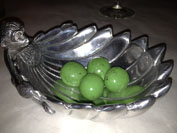
There is apparently not a full-time pastry chef on duty, but that didn’t stop the kitchen from turning out wonderful, sugar-coated beignets (above left) and petits fours, including the insouciently named “monkey balls” (above right).
Without Graydon Carter’s rolodex to rely on, Monkey Bar now needs to earn business the way most new restaurants do: by attracting repeat customers. As of last week, it had its work cut-out for it, although the publicity cycle was only just beginning. I made a last-minute reservation on Friday evening and changed it twice, all without any trouble. The dining room was about half full, although the bar was doing brisk business.
Service was smooth and assured. If you think of Monkey Bar as a two-week-old restaurant, this is a strong start. If you think of it as a place Graydon Carter has been tinkering with for three years, then you wonder if the latest move is just desperation. If Belinda Chang sticks around and Damon Wise’s downtown restaurant is delayed a little longer, Monkey Bar might just grow into something special.
Monkey Bar (60 E. 54th St. between Madison & Park Avenues, East Midtown)
Food: **
Service: **
Ambiance: **
Overall: **

















